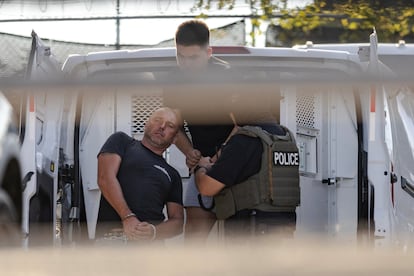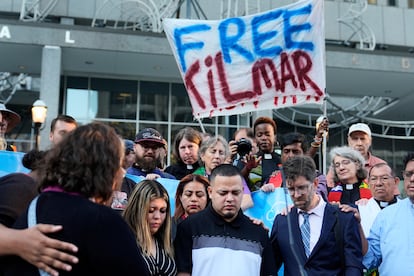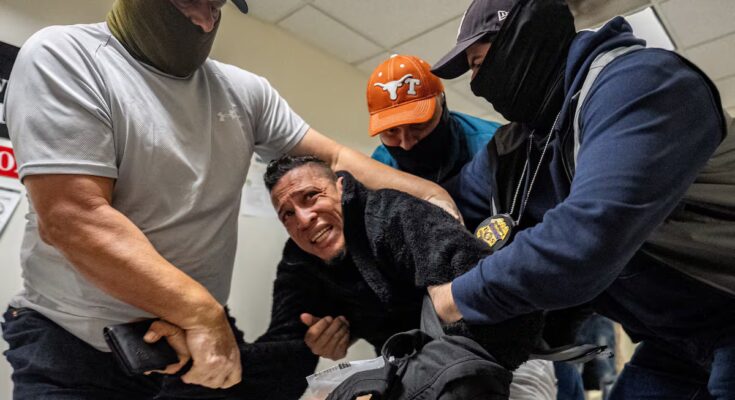Donald Trump is not satisfied with the results of the immigration crackdown he launched as soon as he took office in the White House after winning the elections a year ago. Immigration and Customs Enforcement (ICE) raids “didn’t go far enough,” he said in a recent interview on the CBS program 60 minuteswhere he defended the aggressive tactics of ICE agents, which sparked protests across the country. The Trump administration says it has deported more than 400,000 people since taking office — a large number, but still less than the million deportations the GOP promised, and harder to achieve than he expected.
Trump had already made it clear during the election campaign: if he had won, he would have carried out the largest deportation effort in history. In his first 100 days, the GOP passed 175 immigration-related measures. Most of these actions aimed to increase deportations, but they also closed borders and weakened asylum and refugee programs. The government turned documented residents into undocumented residents, deported workers who had not committed any crimes, separated families, and even detained U.S. citizens.
“It was much more aggressive than anyone expected, more brutal,” says Matt Barreto, a political science professor at the University of California, Los Angeles (UCLA). “He has acted with virtually no regard for the law, violating people’s rights and receiving almost weekly warnings from courts, including his own appointed judges, that his actions are illegal.”
Many of his actions are challenged in the courts, and after his first 10 months in office, it is nearly impossible to keep track of all the rulings issued by district judges and appeals courts. Some of these cases made it to the Supreme Court, which – with its conservative majority – supported several Trump initiatives, such as allowing the use of racial profiling (based on appearance or place of employment) to justify an arrest.
The president’s determination to carry out deportations on a historic scale led him to set aside a huge sum – $170 billion – for immigration enforcement as part of his “big, beautiful” tax reform, passed in July. The funds will be used to expand raids that have proliferated across the country, as well as increase detention capacity through the construction of new immigration centers.
“One of the biggest changes under the Trump administration has been the shift of immigration enforcement to the interior of the United States,” notes Kathleen Bush-Joseph, an analyst at the Migration Policy Institute (MPI). “Under the previous administration, the main goal was to reduce the number of arrivals at the border.”
Back in January, Trump closed entry points, and Customs and Border Patrol (CBP) recorded just 279 daily arrests in September — a 95% decline from the daily average during Joe Biden’s presidency, according to official data. By deploying immigration agents into the hinterland, Trump has effectively opened the door to a large-scale hunt for migrants.
During the previous administration, the priority was to detain undocumented immigrants who had committed crimes. Trump has also promised to focus on deporting criminals – “the worst of the worst” – but in practice, being undocumented has become synonymous with being a criminal. Only 35% of people detained by ICE have criminal records, compared to 65% in October 2024.
The numbers may not satisfy the president, but they are at record levels. When Trump returned to the White House in January 2025, there were 39,000 detainees in ICE custody. By the end of August, that number had risen to 61,000 and could reach 107,000 by January 2026, according to MPI data. The average for September – the most recent month available – was 1,178 arrests per day, still below the daily target of 3,000 set by Stephen Miller, the architect of White House immigration policy.
The wave of ICE raids has spread fear among migrant communities, who have seen eleven sensitive locations – churches, schools and hospitals – lose their protected status. Videos showing officers arresting parents as they dropped their children off at school have gone viral, sparking panic among students.
One of the hardest hit places is immigration courts. Officials take advantage of migrants’ scheduled check-ins – designed to meet government requirements – to detain them, turning what should be a routine appointment into a trap.
Hitting democratic cities
Cities governed by Democrats have been the target of the largest anti-immigration operations. Trump has sent National Guard troops to enforce what he claims is a crime crisis caused by undocumented immigrants in Los Angeles, Washington, D.C. and Memphis.
In Chicago, citizens staged a mass protest against Operation Midway Blitz, an aggressive ICE operation in which Blackhawk helicopters were used for arrests. Federal agents fired pepper bullets and tear gas at protesters who had gathered outside the Broadview Detention Center, in a predominantly black and Latino suburb, to protest the treatment of detainees.
In detention centers like Broadview, children, pregnant women, victims of abuse and migrants without criminal records are crowded together. Detainees and the organizations that defend them report unsanitary conditions, malnutrition and lack of access to drugs and medical care. Many sleep on the floor, with little warm clothing, under bright lights that stay on all night, making rest impossible. According to the complaints, they are also denied communication with their lawyers or family members.
The poor conditions in which detainees are held have been cited as a possible reason why, during fiscal year 2025, 23 people died in ICE custody, the highest number in 20 years. Several family members reported that the deceased had unknown illnesses at the time of their arrest.

ICE detention centers can no longer keep up with the number of detainees, leading to the reopening of shuttered prisons and the construction of new ones — such as the controversial Alligator Alcatraz facility in Florida, which faces lawsuits for holding detainees in inhumane conditions and for being built without environmental studies in a protected wetland. Despite the criticism, the administration plans to create more such centers, allocating $45 billion to the effort.
The lack of space to handle the wave of arrests has led the government to turn to the two largest private prison companies, CoreCivic and GEO Group – both major donors to Trump’s presidential campaign – to manage inmate housing facilities.
Detention is now the standard prelude to deportation. Once detained, migrants are increasingly unlikely to be released. According to MPI data, the percentage of people released on bail, parole or supervision fell from 26% in October 2024 to just 3% in September 2025. In fact, 90% of people detained by ICE in September 2025 were deported directly from detention centers, up from 63% the previous year.
No protection from deportation
Migrant rights organizations report that expulsions are carried out without guaranteeing due process to detainees. Already in March, Trump invoked the Alien Enemies Act of 1889 to deport more than 200 migrants to El Salvador without trial, accusing them of belonging to the Latin American criminal gangs Tren de Aragua and MS-13.
No evidence was ever presented and many of the deportees – who were imprisoned in the notorious Confinement Center for Terrorism (CECOT) – had no criminal record. Some, like the now notorious Kilmar Abrego García, a Salvadoran who is fighting a legal battle against the government and has become a symbol of unjust deportations, even had court orders protecting them from removal.

“This has become a democracy issue. (Trump) is using his immigration policies to undermine democracy in the United States by defying court orders and ignoring laws passed by Congress,” Barreto argues.
Furthermore, to broaden the spectrum of those eligible for deportation, the government eliminated legislation granting legal permanent resident status and work permits to millions of people. Among other actions, he canceled programs such as humanitarian parole and Temporary Protected Status (TPS), created to protect citizens fleeing their countries due to armed conflict, natural disasters, poverty and political crises. Hundreds of thousands of Nicaraguans, Haitians, Cubans and Venezuelans suddenly lost protection from deportation.
For those who cannot be returned to their home countries because their countries refuse to accept them, the administration, with the approval of the Supreme Court, is sending them to third countries such as Rwanda, South Sudan and Swaziland, where human rights are not respected and governments offer no guarantees on the fate of the sport.
The aggressive immigration policy that marked Trump’s first 10 months in office has completely transformed the lives of millions of migrants, as well as those of US citizens. “The Trump administration’s immigration enforcement policy is impacting Americans’ rights, as we’ve seen with detentions, but it has also changed their way of life: They now carry identity documents with them for fear of being arrested or detained,” Bush-Joseph says. “It wasn’t what people expected.”
Sign up to our weekly newsletter to get more English-language news coverage from EL PAÍS USA Edition



